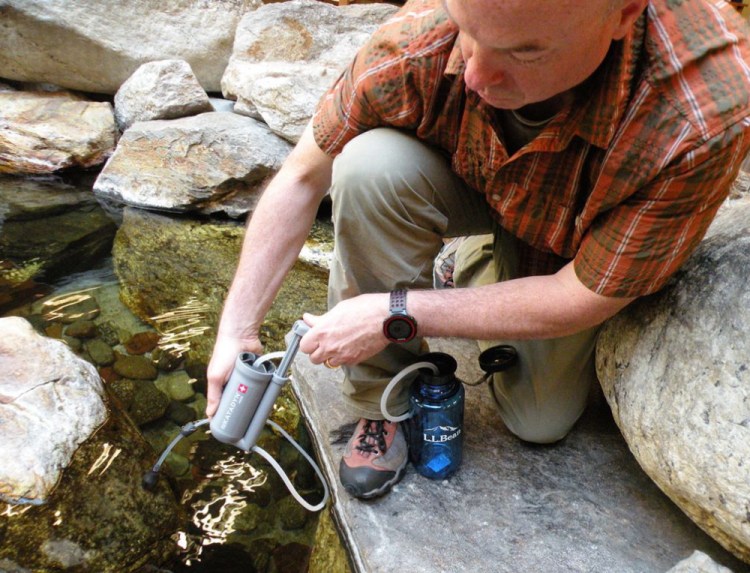You’re out in the Maine woods, miles from the nearest road on a day hike or perhaps a multiday backpacking excursion. You stop at a gurgling stream or the shore of a lovely pond to refill your water bottles. The water is crystal clear and clean looking, so you dip your bottle in and take a long, much-needed drink. The water tastes just fine so you fill your bottles or bladder and continue down the trail.
Soon after you get home from your hike, however, you start to get a queasy feeling in your stomach, then cramps and even a fever. You begin to wonder if perhaps it wasn’t a good idea to drink that untreated water on the trail. But before you can get too far with that thought you’re headed for the toilet, the first trip of many. Yep, you’ve got Giardia, one of the nasty bugs that afflict hikers who consume bad water, and it’s probably going to take a prescription of the antibiotic Metronidazole to get rid of it. No fun.
“There are a lot of pathogens in the water out there, even in remote, pristine areas,” said Kevin Nadeau, a senior product developer at L.L. Bean in Freeport. “There’s no way to know if the water is pure so you should assume that it’s not.”
Besides the protozoan parasite Giardia, which is readily transmitted by way of the feces of deer, beavers, cattle and other mammals, there are bacteria like E. coli and salmonella, cysts and another particularly bad protozoan known as Cryptosporidium in the Maine backcountry. Viruses in the water are only a concern for trekkers overseas, so you can skip worrying about that one.
“The danger of not treating your water is intestinal distress, diarrhea, vomiting and a high, flu-like fever,” said Nadeau. “Then severe dehydration becomes a big risk. It can take anywhere from two days to two weeks to get rid of it.”
Fortunately there some really good products on the outdoor market today that make short work of producing safe drinking water on the trail, from filter systems to chemical treatment to ultraviolet or UV treatment, and Nadeau was kind enough to review them each with me.
FILTER SYSTEMS
Pump filters have been around for a while. Easy and effective to use, you just put one end of the hose in the water, the other in your bottle and pump. But pumping can take a while and as such can be tiring, especially as the filter starts to clog with use. Pump filters weigh about a pound. Gravity-feed filters are a relative newcomer. Fill the bag with water and hang it up to let gravity force the water through the filter into a second bag or bottle. It’s a quick way to filter large quantities of water.
ULTRAVIOLET TREATMENT
UV lights are quick and easy to use, lightweight and pack small. Simply turn on the wand (takes a battery) and insert into your water bottle and let the light do its thing. The drawback with the UV light is that you have to start with clear water; murky water won’t do. This method also does nothing for taste or for floaties.
CHEMICAL TREATMENT
Remember the awful tasting iodine-based tablets of years past? Yuck. Today’s chlorine-based treatments – the same chemicals used in municipal water – are a huge improvement over iodine. Simply drop a tablet or two or squeeze a few drops of the chlorine chemical into your water and wait, usually anywhere from a half-hour to an hour, depending on the water and what you’re trying to kill. Tablets and drops weigh next to nothing. Look for brand names like Katadyn, MSR, Platypus, Steripen and Aqua Mira, and choose what works best.
Carey Kish of Bowdoin is editor of the AMC Maine Mountain Guide. Follow Carey’s adventures in his Maineiac Outdoors blog at:
mainetoday.com/blog/maineiac-outdoors
Send questions/comments to the editors.



Success. Please wait for the page to reload. If the page does not reload within 5 seconds, please refresh the page.
Enter your email and password to access comments.
Hi, to comment on stories you must . This profile is in addition to your subscription and website login.
Already have a commenting profile? .
Invalid username/password.
Please check your email to confirm and complete your registration.
Only subscribers are eligible to post comments. Please subscribe or login first for digital access. Here’s why.
Use the form below to reset your password. When you've submitted your account email, we will send an email with a reset code.